It happens every year, in what seems like every grade level…students continually call a rhombus a diamond. Last year, when we heard 3rd graders saying just this, Christopher helped the 3rd grade teachers and me put the students’ thinking to the test with a Which One Doesn’t Belong he created.
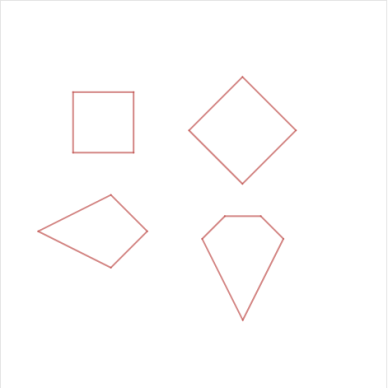
This year, at the beginning of the geometry unit, we heard the diamond-naming again along with some conversation about a rectangle having to have 2 long sides and 2 short sides. What better way to draw out these ideas for students to talk more about them than another Which One Doesn’t Belong? We changed the kite to a rectangle this time, hoping we could hear how they talked about it’s properties a bit more.
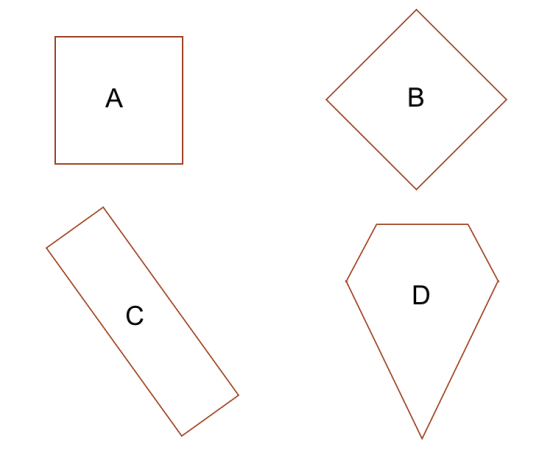
Overwhelmingly, the class agreed D did not belong because it had “5 sides and 5 corners” and eventually got around to calling it a diamond, which in their words was “not a real shape.”
While we knew a lot of things could arise, our purpose was diamond versus rhombus conversation, so of course the students had other plans and went straight to the square versus rhombus.We wouldn’t expect anything different!:) For every statement someone had about why the square or rhombus did not belong, there was a counter-statement (hence the question marks in the thought bubbles).
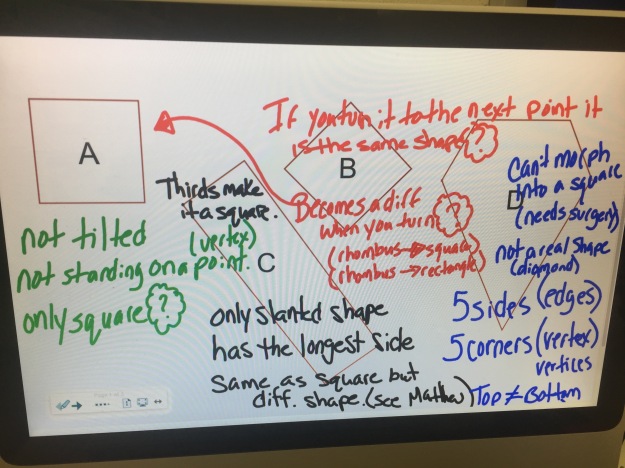
Jenn, the teacher, and I were really surprised at how much orientation of A and B mattered to the name they gave the square and rhombus but did not matter for the rectangle. That was just a rectangle, although one student did wonder if a square was also a rectangle (he heard that from his older sister). The students had so many interesting thoughts that we actually had to start a page with things they were wondering to revisit later! That distributive property one blew me away a bit!:)
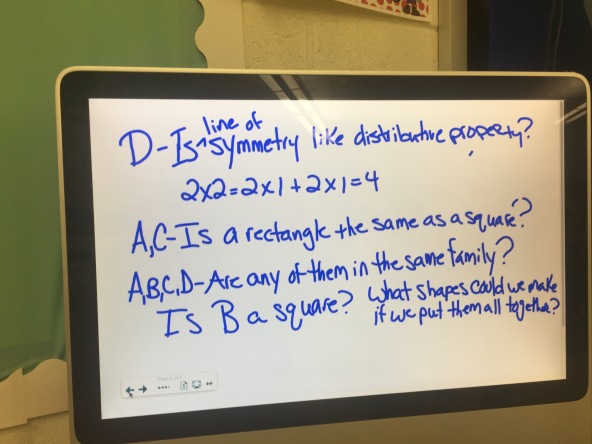
We then sent them back to journal because we wanted to hear how they were categorizing a square and rhombus. It ended up being really interesting just seeing them try to explain why they were different and change their mind because they just started turning their journals around!
Some stuck with them being different..

Some thought they were different, but one could become the other…
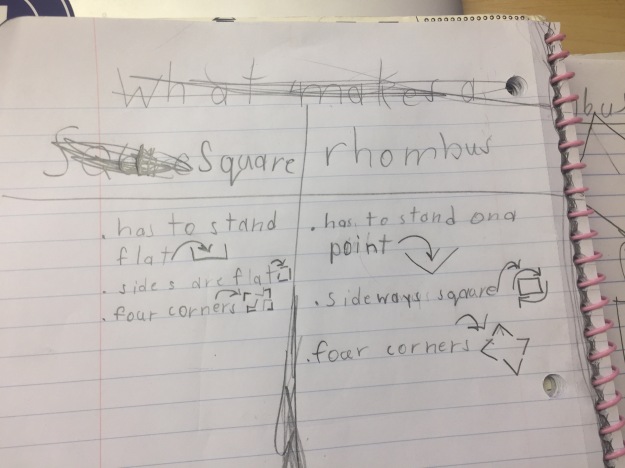
Some were wavering but the square was obviously the “right way.”
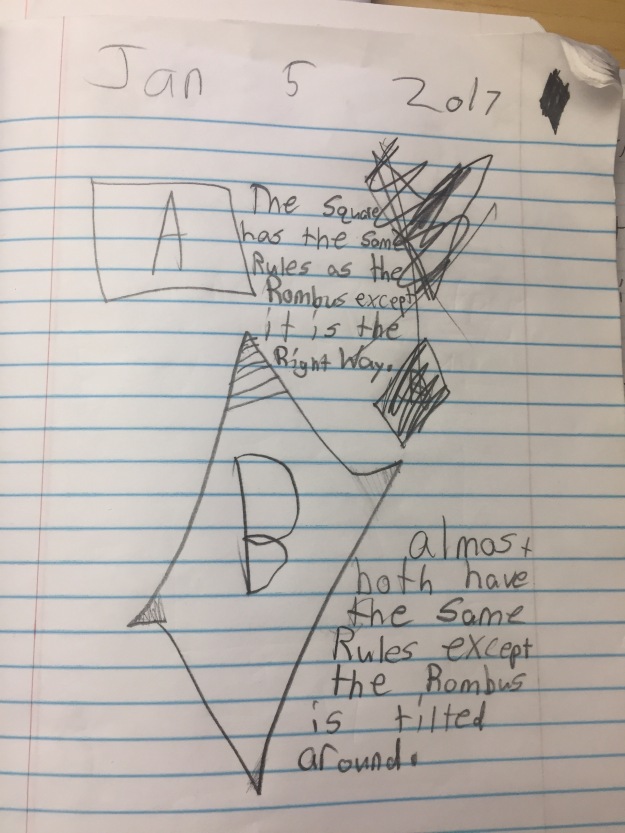
Some argued they were the same…
So much great stuff for them to talk about from here! I left wondering where to go from here? In thinking about the math, is it an orientation of shapes conversation? or Is it a properties conversation? In thinking about the activity structure, would you pair them up and have them continue the conversation? Would you throw the rectangle into this conversation? Would you have some playing with some pattern blocks to manipulate? Would you pull out the geoboards? I am still thinking on this and cannot wait to meet and plan with the 3rd grade team!
However, before I left school today, I went back to the 3rd grade standards to read them more closely: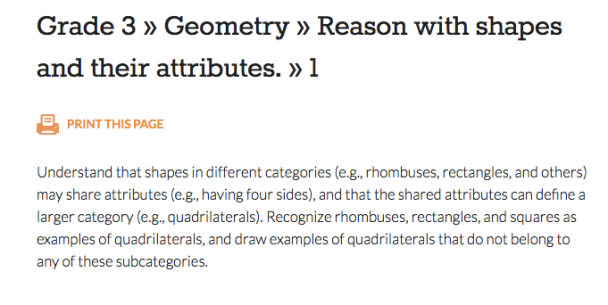
and read the Geometry Learning Progressions, only to find this in 1st grade:
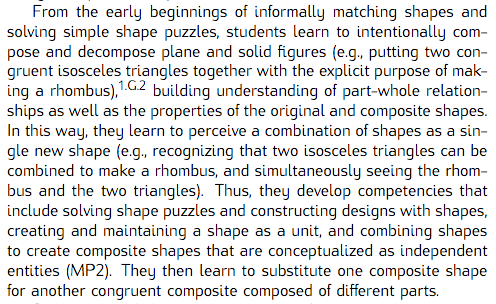
Would love to hear any thoughts and ideas in the comments!



I was recently having a conversation with my 1st grade teachers about their geometry standards. I found this task from Illustrative Mathematics that helps students understand what constitutes defining attributes and then helps them verbalize it by using the sentence frame “All triangles _________, but only some triangles _______________. This might help your 3rd graders (using rhombus) with the orientation aspect of their investigations. Here’s a link to the task https://www.illustrativemathematics.org/content-standards/1/G/A/1/tasks/752
LikeLiked by 1 person
That is such a great idea Nancy! Such a coincidence because I have that exact activity to use with the 1st grade next week!! Never even thought about adapting it for this case! Thanks so much!
LikeLike
“Christopher helped the 3rd grade teachers and I put the students’ thinking to the test”
Only since you teach K-5, I will point out that it’s “helped the teachers and me.” You wouldn’t say, “Christopher helped I,” would you? Americans seem to struggle with compound subjects and objects because I suspect, they get yelled at as children by parents for saying “My friend and me went to the store, ” which is, in fact, wrong, to such an extent that they become afraid to EVER use “x and me.” But when the compound form is an object, then “me” is correct. My son’s mom never accepted that it’s not correct to say, “He sat between she and I,” and correct to say, “He sat between her and me,” even though she knew it was wrong to say “Please sit next to I.”
That said, great post as usual. I would love to have the chance to work with K-5 math teachers again.
LikeLike
Thanks so much, I never do much proofreading when writing my blog (although I completely should;). Going in to change that now! Thanks!
LikeLiked by 1 person
Any time. I’m one of those demented people who has graduate degrees in literature and math education. I did legal proofreading to make ends meet several times in the ’80s. I don’t do as well with my own writing, though: I tend to see what I think I wrote instead of what I did. 😦
LikeLiked by 1 person
I wonder…if you loosely arranged a variety of geometric shapes on a table, including squares and rombuses (aka “diamonds”) and asked your students to pick up all the squares, what do you think they would do? Would having physical shapes to sort and turn and move make orientation a non-issue and allow them to focus on attributes? Orientation limits understanding measurements like base and height as well. Looking forward to your next post!
LikeLiked by 1 person
Always impressed in what our students know and can do! Their thinking amazes me! Thanks Kristin and Jenn!
LikeLike
I’m curious about the students’ categorization of the B shape as a rhombus because of its orientation being on a point. To be a rhombus, the quadrilateral needs to have 4 equal sides and that’s it. Squares need to have 4 equal sides and 4 right angles. So all squares are rhombuses but not all rhombuses are squares. To me, both A and B are squares (and also rhombuses since they have the 4 equal sides). I would not categorize A as a square and a B as a rhombus. Isn’t it true that squares remain squares no matter how we turn it? It reminds me of triangles when we turn it upside down and students don’t recognize them for their appropriate categorizations because they have usually only seen them one way such as lying flat on one side.
LikeLike
Your last thought about only seeing the triangles one way reminds of some examples Jo Boaler put in her Mathematical Mindsets book. She mentions we have to be careful of creating anchor charts with just standard regular examples for instance regular polygons, or the two line example of parallel lines. When students consistently see these examples they have a hard time recognizing that any shape with 8 sides is an octagon and not just the stop sign example that is often posted. Same as they often won’t recognize 3 lines running parallel as parallel lines since they often only see an achor chart version of two line running parallel.
LikeLiked by 1 person
I think it would have been beneficial to add a non-square rhombus (no right angles). I think this might have brought out the distinction between their characteristics.
LikeLike
You’ve got to read WODB! C takes this on really well.
LikeLike
An fascinating discussion will probably be worth comment. I’m sure you should write more about this topic, it might often be a taboo subject but normally people are too little to dicuss on such topics. To another location. Cheers
LikeLike